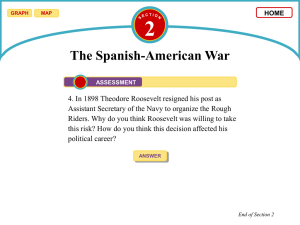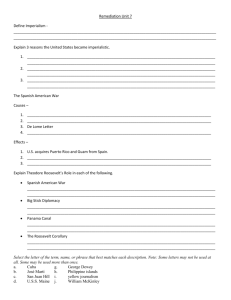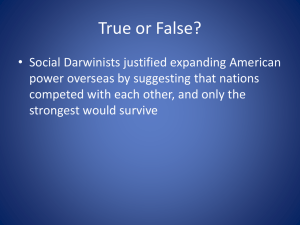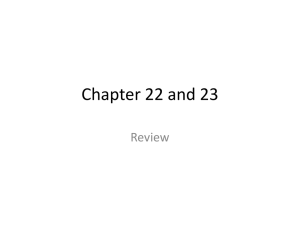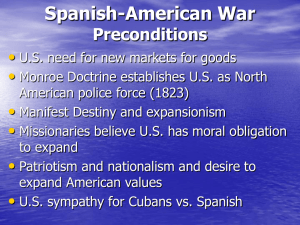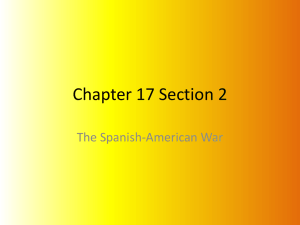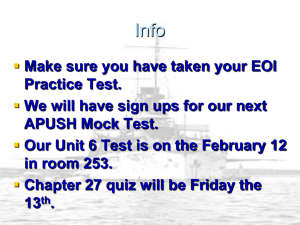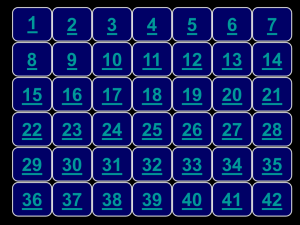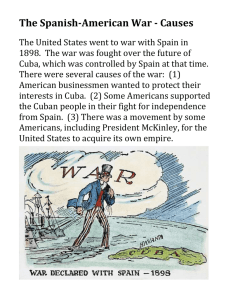Chapter 23: An American Empire
advertisement
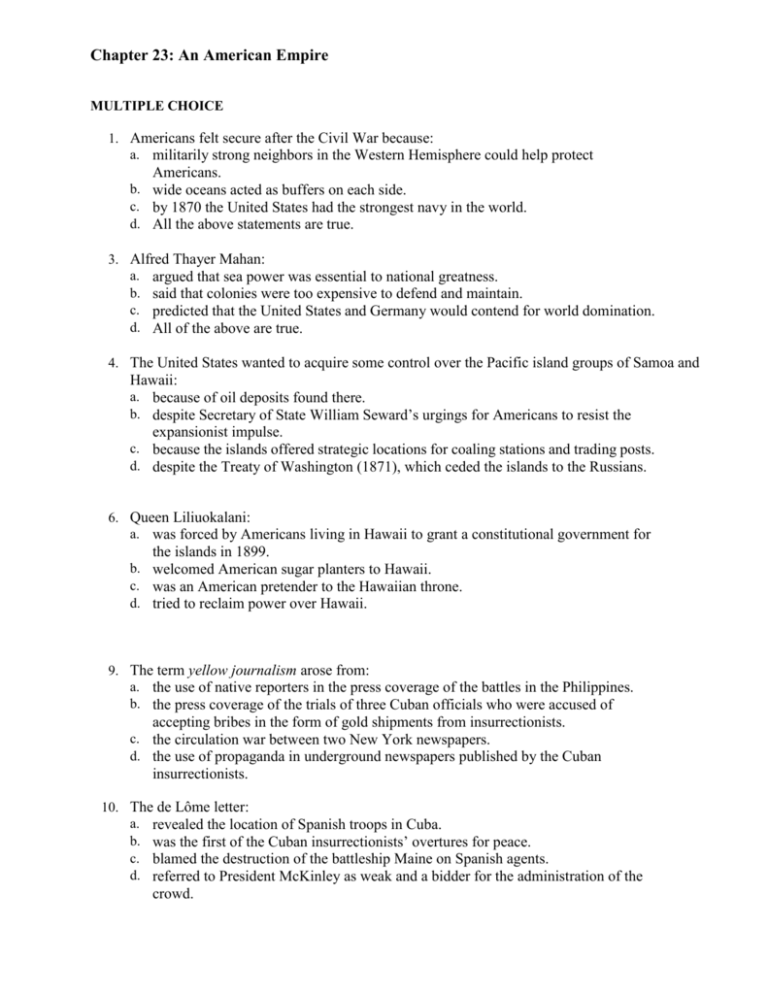
Chapter 23: An American Empire MULTIPLE CHOICE 1. Americans felt secure after the Civil War because: a. militarily strong neighbors in the Western Hemisphere could help protect Americans. b. wide oceans acted as buffers on each side. c. by 1870 the United States had the strongest navy in the world. d. All the above statements are true. 3. Alfred Thayer Mahan: a. argued that sea power was essential to national greatness. b. said that colonies were too expensive to defend and maintain. c. predicted that the United States and Germany would contend for world domination. d. All of the above are true. 4. The United States wanted to acquire some control over the Pacific island groups of Samoa and Hawaii: a. because of oil deposits found there. b. despite Secretary of State William Seward’s urgings for Americans to resist the expansionist impulse. c. because the islands offered strategic locations for coaling stations and trading posts. d. despite the Treaty of Washington (1871), which ceded the islands to the Russians. 6. Queen Liliuokalani: a. was forced by Americans living in Hawaii to grant a constitutional government for the islands in 1899. b. welcomed American sugar planters to Hawaii. c. was an American pretender to the Hawaiian throne. d. tried to reclaim power over Hawaii. 9. The term yellow journalism arose from: a. the use of native reporters in the press coverage of the battles in the Philippines. b. the press coverage of the trials of three Cuban officials who were accused of accepting bribes in the form of gold shipments from insurrectionists. c. the circulation war between two New York newspapers. d. the use of propaganda in underground newspapers published by the Cuban insurrectionists. 10. The de Lôme letter: a. revealed the location of Spanish troops in Cuba. b. was the first of the Cuban insurrectionists’ overtures for peace. c. blamed the destruction of the battleship Maine on Spanish agents. d. referred to President McKinley as weak and a bidder for the administration of the crowd. 11. The battleship Maine: a. exploded as it left Miami for Cuba. b. became a battle cry in the Spanish-American War, although blame for the explosion could never be fixed. c. carried arms to the Cuban insurrectionists. d. disappeared at sea with no trace, but newspaper reporters claimed that Spain had ordered it sunk. 12. The Teller Amendment: a. was added to an army appropriation bill in 1901. b. called for universal suffrage in America’s new possessions. c. was defeated in the Senate. d. disclaimed any American designs on Cuban territory. 14. The first major victory for American forces in the Spanish-American War was at: a. San Juan Hill. b. Santiago. c. Manila Bay. d. Havana. 15. In the Spanish-American War: a. America’s victory could in large part be attributed to expert preparation. b. more American soldiers died from disease than from battle. c. the American victory in the decisive battle at Santiago depended on assistance from German forces. d. America finally settled the question of freedom of the seas. 17. During the Spanish-American War, Theodore Roosevelt: a. served as Secretary of the Navy. b. was a war correspondent for the New York Journal. c. took part in the land fighting in Cuba. d. destroyed the Spanish fleet at Manila Bay. 18. The Secretary of State who proclaimed the Open-Door Policy toward China was: a. John Hay. b. Henry Adams. c. William Seward. d. Albert Beveridge. 19. The Open-Door Policy, if rooted in the self-interest of American businessmen and their desire to exploit Chinese markets, also: a. was supported by American imperialists. b. showed America’s concern for social justice. c. could be used as a training ground for the U.S. military. d. tapped the deep-seated sympathies of those who opposed imperialism. 20. The treaty ending the Spanish-American War: a. was opposed by most Democrats and Populists. b. was ratified in the Senate over the protests of William Jennings Bryan. c. provided for Spain to pay to the United States $10,000 for each American soldier killed in the war. d. provided for Hawaiian autonomy. 21. Emilio Aguinaldo: a. was the Filipino rebel leader. b. led the Spanish forces at San Juan Hill. c. was installed as Cuba’s governor in 1898. d. was the martyred leader of the Cuban rebellion. 22. In 1900, when Theodore Roosevelt was nominated as vice president, he served as: a. governor of New York. b. secretary of the Navy. c. assistant secretary of the Navy. d. secretary of state. 23. Toward the end of his presidency, Roosevelt displayed American power by: a. announcing the annexation of the Dominican Republic. b. doubling the size of the U.S. Army. c. sending the U.S. fleet on a world tour. d. starting an air force. 24. William McKinley was assassinated: a. in 1898. b. in 1903. c. by Charles Guiteau. d. by Leon Czolgosz. 25. The publisher of the New York Journal was: a. Henry W. Grady. b. William Randolph Hearst. c. John Keating. d. Frederick Jackson Turner. 26. The Platt Amendment: a. granted U.S. citizenship to inhabitants of Puerto Rico. b. arranged for a Cuban election to decide the issue of annexation. c. sharply restricted the independence of Cuba’s new government. d. set up the Army Yellow Fever Commission under Dr. Walter Reed. 28. Roosevelt’s intervention in the Russo-Japanese War and the Moroccan dispute: a. strained America’s relations with Russia. b. won him the Nobel Peace Prize of 1906. c. involved the use of armed forces without the consent of Congress. d. weakened his image around the world. 29. Who was president when the United States acquired the right to build a canal across Panama? a. Grover Cleveland b. William Jennings Bryan c. William McKinley d. Theodore Roosevelt 31. Theodore Roosevelt: a. had a Ph.D. in chemistry. b. was the first southern-born president after the Civil War. c. was a Democrat. d. loved the outdoors and was, for a brief time, a cowboy. 33. When the United States and Colombia could not agree on a price for the Canal Zone: a. the matter was submitted to an international board for arbitration. b. President Roosevelt sent the army to force Colombian leaders to accept the American offer. c. the Colombian province of Panama rebelled against Colombia. d. Colombian leaders offered the deal to the British. 34. The Roosevelt Corollary: a. encouraged American bankers to help finance shaky Latin American governments. b. stated that the United States could intervene in the affairs of Western Hemisphere countries to forestall the intervention of other powers. c. rescinded most of the provisions of the Monroe Doctrine. d. justified American intervention in the Far East. 35. As a result of Japan’s show of strength in the Russo-Japanese War: a. Congress voted financial and military aid to Korea to help prevent a Japanese invasion of the Korean peninsula. b. America was quick to send money and support troops to aid Russia. c. Congress lifted the limitations it had previously set on Japanese immigration. d. Americans began to doubt the security of the Philippines.
